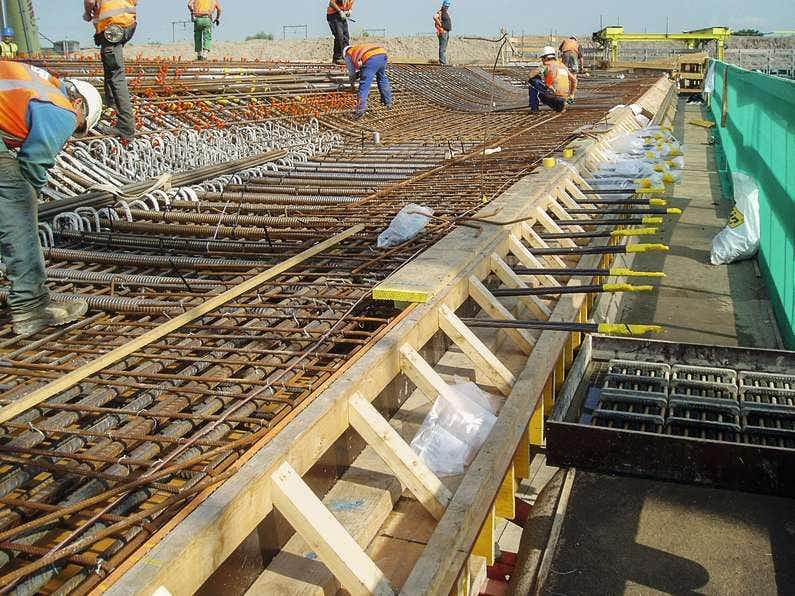Success with Know-How and Tendons: New Bridges for Nijmegen and Lent
As a result of climate changes, water in the Waal River may reach levels which exceed its capacity and therefore dangerous for the inhabitants of Nijmegen, the oldest city in the Netherlands. In order to cope with this problem, a unique project that is called “Room for the Waal River” was launched. As a result, a new island will be created between the old river bed and the new channel.
Within the scope of this project, approx. 5 million m³ of earth will be moved, and a new ancillary channel will be created along the village of Lent located on the North side of the Waal River. This new island will be used for urban development and recreational activities. The project also required new infrastructure: Among other things, a few new bridges had to be built, and the existing Waal Bridge on the A 325 motorway had to be lengthened.
Lengthening of the Waal Bridge: A Challenge
The steel arch bridge over the Waal was extended by a 278m long concrete arch bridge which was designed by Zwarts & Jansma Architects from Amsterdam. The new structure consists of two 79m long main spans and two 57 and 63m long side spans. The cross section of the bridge is approx. 34m wide and consists of six cells divided by 5 vertical walls. The geometry of the bridge is very complicated as it curves in all directions; consequently, the formwork for the entire bridge was a real challenge for the contractor.
In the bridge deck, 211 Type 9-0.62" DYWIDAG Strand Tendons with SD 6809 Anchorages were used as transverse tendons. DYWIDAG gradually installed, stressed and grouted the tendons in the 5 construction stages necessary for the erection of the bridge arches. The longitudinal tendons are situated in the vertical walls between the bridge cells – in total, there are 36 Type 31-0.62" DYWIDAG Tendons. After the last bridge arch had been cast, the strands for the approx. 300m long post-tensioning tendons were pushed in, tensioned and grouted. At both ends of the bridge, the DYWIDAG Tendons were stressed using Type MA 6831 Stressing Anchorages, i.e. there are no intermediate anchors or couplers.
The Promenade Bridge: Lean Structures with DYWIDAG Tendons
Ney - Poulissen Architects & Engineers from Brussels designed the Promenade Bridge as an extremely slender structure with a very thin deck that is curved in all directions. The bridge is 222m long and features 5 spans in different lengths – the longest span is 56m long, and the shortest side spans measure 30m. This bridge was especially designed for pedestrians, cyclists and local traffic to the new island.
Due to the complex geometry and the very limited thickness of the bridge deck, which ranges from approx. 600mm in the middle of the cross section to 320mm at the ends, the construction of the bridge was extraordinarily challenging. The bridge deck was erected in three construction stages in lengths of 97, 57 and 68m.
The transverse post-tensioning of the slender bridge deck was carried out using 277 Type 4-0.62" DYWIDAG Strand Tendons with SD 6804 Plate Anchorages. The length of these tendons varies from16 to 23m. In the longitudinal direction, 12 Type 22-0.62" DYWIDAG Tendons were installed. The individual tendons were force-fitted using intermediate stressing anchors with Type R 6822 Couplers. Furthermore, 4 Type 22-0.62" DYWIDAG Strand Tendons with MA 6822 Anchorages were installed in two transverse girders between the inclined bridge columns.
Parmasingel Bridge and Citadel Bridge: Efficiency with DYWIDAG Tendons
The Parmasingel and the Citadel Bridge were built using precast, prestressed concrete elements. The Parmasingel Bridge on the A 325 motorway is about 32m long and 28m wide. It consists of 18 precast concrete segments which were assembled to form a box girder on the jobsite using 53 transverse Type 4-0.62" DYWIDAG Tendons and SD 6804 anchorages.
The Citadel Bridge is a curved bridge for pedestrians and cyclists. It consists of 7 spans with 2 longitudinal precast concrete beams that act as a bearing structure for the light, 5.7m wide bridge deck. Each beam has a cross section of 1,200 x 900mm in which 4 Type 18-0.62" DYWIDAG Tendons and Type MA6819 Stressing Anchorages were applied. The tendons were tensioned and grouted prior to the transportation of the beams from the precast concrete yard to the jobsite.
Successful Project Realization with DYWIDAG
The construction work on the bridges started in 2013 and is scheduled for completion at the end of 2015. DYWIDAG supplied, installed, tensioned and grouted DYWIDAG Strand Tendons with a strand weight of approx. 600t for this project. All of the tendons incorporated Type 0.62", St 1860 N/mm² strands.
In addition, DYWIDAG assisted the General Contractor in the final design of the post-tensioning systems for all bridges. The know-how and the experience of the DYWIDAG employees contributed to the optimization and the successful realization of this major project.
DYWIDAG is proud to have contributed with expertise and high quality DYWIDAG Products to this project which ensures that Nijmegen and Lent will be safe from floods in the future.






